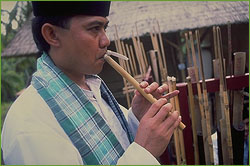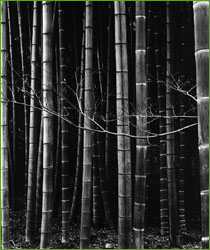
|
 |
Nature's Miracle Material The NOVA team of experts in "China Bridge" lashed together the wooden structure of their Rainbow Bridge using rope woven with strips of bamboo. Bamboo rope may come as a surprise to many Westerners, but it shouldn't, as people throughout history have used this versatile grass in perhaps more ways than they have used any other plant in the world.
The Chinese in particular have put it to a wide variety of uses. In the Chinese countryside, a person's life, from cradle to grave, can be measured with bamboo. Until recently, doctors often cut umbilical cords with a finely sharpened bamboo knife. Today, Chinese parents rock infants in bamboo cradles, and children play with bamboo toys or blow bamboo flutes. As adults, peasants shape the ground with bamboo tools and, in the spring, may enjoy a feast of bamboo shoots. When one's journey is over, relatives carry the deceased to the grave on a bamboo bier. "Bamboo can do so much for farmers' daily needs, and all they need to make it work for them is a knife or a machete," says Dr. Jules Janssen, a Dutch civil engineer who has researched bamboo for a quarter century and also lent his expertise to NOVA for "China Bridge." A Striking Versatility Bamboo is many things to many millions of people. Its tensile strength has been compared to steel, and larger varieties have the density of a hardwood. Yet early in their lives, other varieties serve as food for people and certain animals. The plant's colors run from white to a glossy black, though most common varieties are green. Some types grow only an inch or so high; others tower to heights of 120 feet with stalks a foot in diameter.
Its diversity of attributes has led to bamboo's diversity of uses. "It sounds like a joke, but the list of things bamboo is not used for is shorter than the list of things it is used for," says Janssen, who then offers an almost stream-of-consciousness list of bamboo products. "It's used for firewood, fences for the cattle, heating fuel, a house's walls and roof. Out of it you can make boats, rafts, furniture, veneer, parquet flooring, paper. And then there's the bamboo flute, which you can find practically everywhere in the world." He pauses and then asks, "Is that enough?" Janssen's point is well-made. The Environmental Bamboo Foundation has printed a bamboo alphabet that lists numerous bamboo uses under each letter. The "A" entry includes the words aphrodisiac, acupuncture needles, awnings, and more; "B" lists bagpipes, books, and brooms; the sole "E" entry is egg cups. Even the rarest initial letters, such as "V" (valiha, a musical instrument from Madagascar), "X" (xylophones), and "Z" (zithers), are covered by bamboo. The only letter that lacks an entry is "Q," and one expects it has more to do with our linguistic limitations than the shortcomings of bamboo.
About 1,000 species of bamboo grow throughout the world. Actually a grass, the plant exists naturally on every continent except Antarctica. It has found a niche for itself in sea-level tropics and on 13,000-foot mountain slopes. One of bamboo's less obvious gifts is its root system, which is more highly developed than it is in most other plants and provides strong protection against riverbank erosion, Janssen notes. With a wide range of colors, shapes, and sizes, the various bamboo species share just one common characteristic: the woody and often strong stalk, called a culm. What makes the culm so extraordinary is its combination of lightness and strength. The lightness comes from its hollow center, while its remarkable strength arises from its walled septa, or nodes, which reinforce the stalk, giving it redundant support over its entire length. Continue: Bamboo can outgrow any other plant in the world. NOVA Builds a Rainbow Bridge | Bridge the Gap | Nature's Miracle Material China's Age of Invention | Resources | Transcript Medieval Siege | Pharaoh's Obelisk | Easter Island | Roman Bath | China Bridge | Site Map Editor's Picks | Previous Sites | Join Us/E-mail | TV/Web Schedule About NOVA | Teachers | Site Map | Shop | Jobs | Search | To print PBS Online | NOVA Online | WGBH © | Updated November 2000 |


